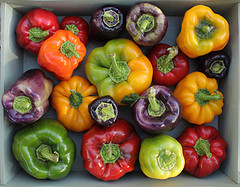Red Bell Peppers for the Heart
 The bell pepper is a member of the nightshade family of vegetables, which includes potatoes, eggplants, and tomatoes. They are available in several colors: green and purple peppers have a slightly bitter flavor, while red, orange, and yellow peppers are sweeter and almost fruity. Red bell peppers are actually green peppers that have been allowed to ripen on the vine. The spices pimento and paprika are both prepared from red bell peppers.
The bell pepper is a member of the nightshade family of vegetables, which includes potatoes, eggplants, and tomatoes. They are available in several colors: green and purple peppers have a slightly bitter flavor, while red, orange, and yellow peppers are sweeter and almost fruity. Red bell peppers are actually green peppers that have been allowed to ripen on the vine. The spices pimento and paprika are both prepared from red bell peppers.
Bell peppers are one of the most nutrient-dense foods available. It is a good source of a large number of nutrients, including vitamin C, beta-carotene, vitamin K, thiamine, folic acid, and vitamin B6. Bell peppers are also a very good source of phytochemicals with exceptional antioxidant activity. Red bell peppers have significantly higher levels of nutrients than green. Red bell peppers also contain lycopene, a carotene that offers protection against cancer and heart disease.
Studies have shown that bell peppers exert a protective effect against cataracts, possibly due to their vitamin C and beta-carotene content. However, like other nutrient-dense vegetables, they contain many different powerful phytochemicals. Bell peppers also contain substances, including capsaicin, flavonoids, and vitamin C, which have been shown to prevent blood clot formation and reduce the risk of heart attacks and strokes. Bell pepper consumption should be promoted for individuals with elevated cholesterol levels.
Bell peppers should be smooth, firm, bright and feel heavy for their size! They can be stored in the refrigerator for up to a week. They are great raw, grilled, roasted and more! Throw them in your next stew, soup or salad. Enjoy!

